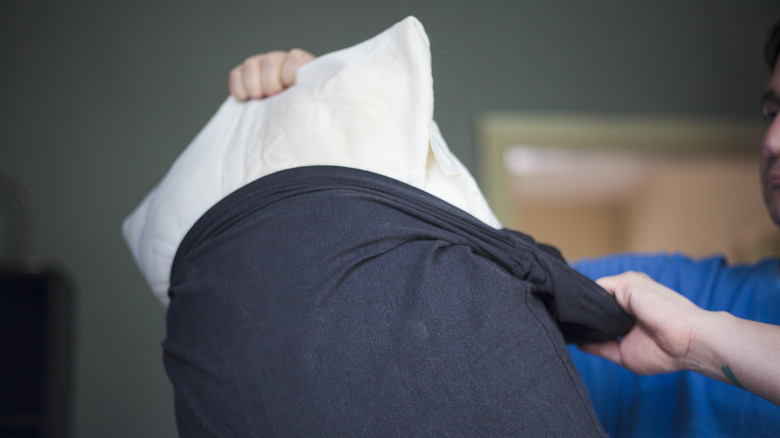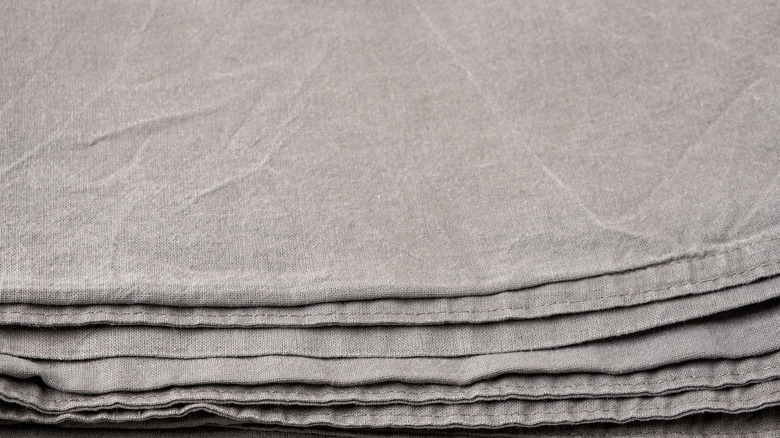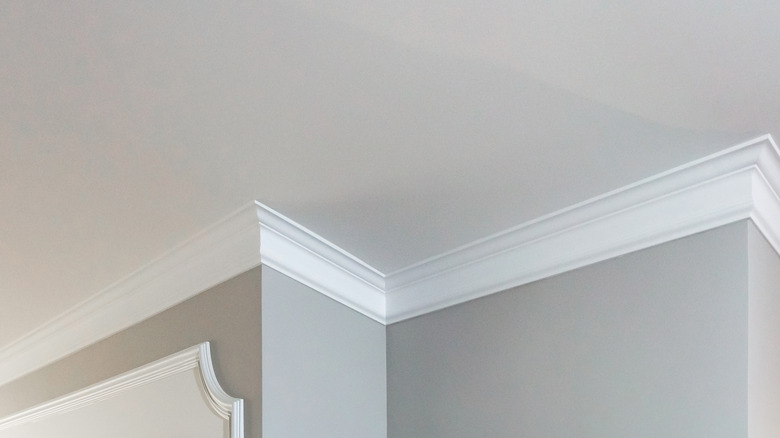How To Use A Pillowcase To Clean Your Ceiling Corners
If you're a conscious consumer, you know that upcycling old items is a small way to live a greener, more sustainable life. Any little thing helps, and when it comes to your bed linens, you probably have several old spare pillowcases lying around your closet. Why not put those unwanted pillowcases to use instead of tossing them to sit in a landfill?
Old pillowcases can come in handy for many projects around the house, from organizing your current linens to storing your sweaters. One particularly handy use for those pillowcases is cleaning. Between the ideal fabric for gently picking up dust and dirt (cotton being the most common, but you'll also find satin, nylon, and linen pillowcases) and the fact that a pillowcase is generally a large bag, you'll be able to easily upcycle this bedding staple into something useful when you've decided you no longer want to sleep on it. One particularly tricky place to clean that a pillowcase can assist you with? Pesky ceiling corners filled with dust and cobwebs. Read on to find out how to swipe your ceiling corners with an old pillowcase in no time.
How to use a pillowcase to clean your ceiling corners
You'll need a few items to clean your ceiling corners effectively: a broom, an old pillowcase, a safe cleaning solution, a paint roller, and another pillowcase or microfiber cloth for further deep cleaning. Once you've gathered your materials, take stock of your ceiling and dirty corners. Carefully slip your pillowcase over the broom head and secure it. Now, run your broom along the corners of your ceiling to grab dust and cobwebs that may have formed. You might need to do this a few times to adequately clean the corners and debris. If you're planning on deep cleaning your walls and ceiling, this step is crucial so that leftover dust and dirt aren't spread around. Consider laying a tarp or old sheet down on the floor, too — this will help catch falling dust and make floor cleanup a breeze.
If you're especially allergy-prone or like to keep your windows open, cleaning your ceiling corners and the rest of the ceiling should probably be done once a month, at a minimum. If indoor allergies are not a problem for you, you can probably stick to once-a-season cleaning. Looking to dive into a deeper cleaning of your ceiling? You can create an at-home cleaning mixture of vinegar, warm water, and dish soap and apply the mixture using an old spray bottle. Of course, though, depending on your paint and finish, consider tailoring your cleaning solution to the type of paint you have so you don't inadvertently damage it.
Flat and eggshell paint finishes should be cleaned with mild dish detergent or hand soap mixed with water — and don't be too aggressive, as scrubbing too hard will take the paint right off your walls. Glossy and semi-glossy paints can withstand more, so feel free to use degreasing dish soap (Dawn dish soap comes to mind). As always, if you're worried about potential damage, test a small, unnoticeable spot of the ceiling before wiping down the entire thing. Once you have your ideal cleaning solution, gently clean your ceiling and walls using a clean, damp paint roller (another upcycling cleaning hack!), not oversaturating the surfaces you're working on. If you have another clean pillowcase or a microfiber cloth, you can dab your newly cleaned ceiling and walls to dry them.
Why you should use a pillowcase to clean your ceiling corners
Before you take an old broom to your ceiling corners, take a minute to think about what you might damage. Brooms can be scratchy, and unthinkingly sweeping your ceiling corners with a broom can lead to scratched paint on the wall and ceiling you're trying to clean. Enter your nifty, old pillowcase. Old pillowcases make great cleaning rags since they're soft, won't damage surfaces, and easily pick up dirt, dust, and debris.
A popular cleaning hack uses a pillowcase to dust your ceiling fans since the dust will slide off the fan blades and into the case easily. You'll want to make sure the pillowcase you're using isn't completely threadbare since this might counteract the protective qualities of using the pillowcase in the first place. For best results, choose an old pillowcase with some life left in it and doesn't risk falling apart.


